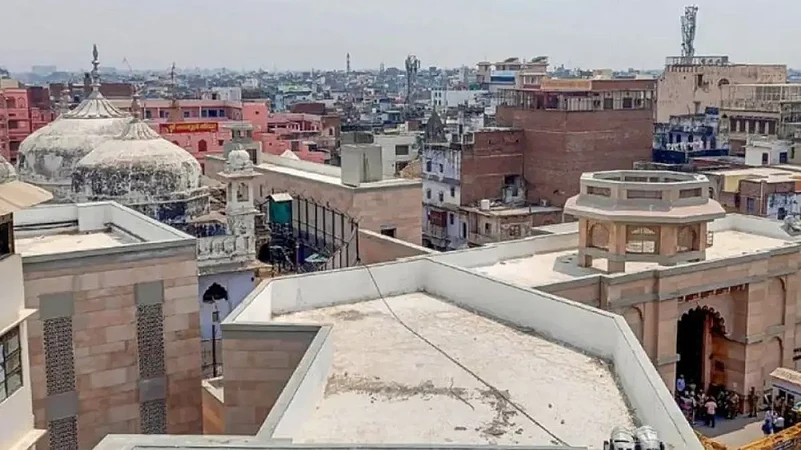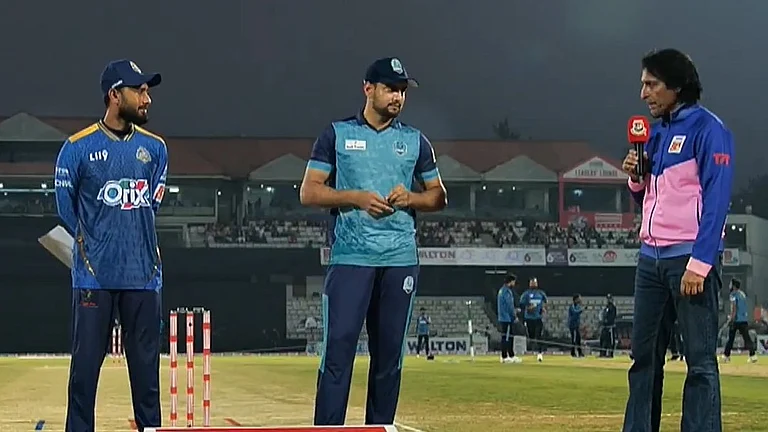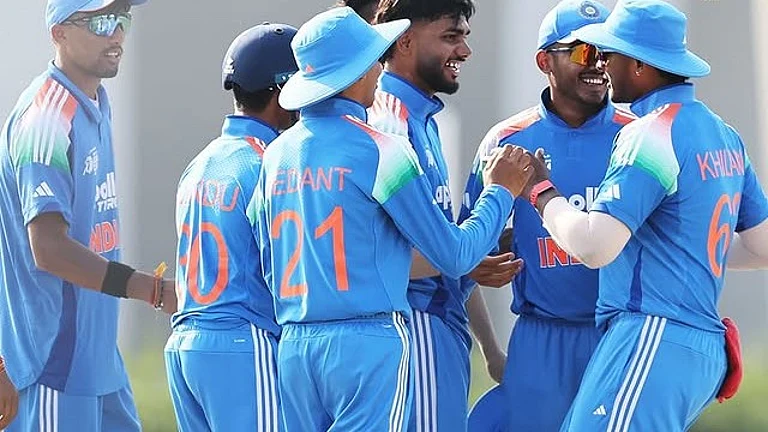On May 16, after the court-mandated videography survey of the Kashi Vishwanath Temple-Gyanvapi Mosque complex in Varanasi concluded, the counsel representing the Hindu side claimed that a Shivling was found close to the wuzukhana, a small reservoir used by Muslims to perform ablutions before offering the namaz. The claim, and the subsequent Supreme Court verdict in the case, was covered differently by the Urdu, Hindi and English newspapers. This only proves how journalism, the fourth pillar of democracy seen as history written in a hurry, remains beset by the sins of partisanship today.
Terming the claim as ‘fascist,’ Urdu daily Siasat, which is in the 74th year of its publication, carried an incisive editorial on May 17, in which it lamented that it had become commonplace in the country to play with the law of the land in the name of religion. The latest episode, it argued, was an attempt to foment hatred between the two communities after the communal forces were emboldened by the resolution of the Babri Masjid dispute through court on the basis of faith. Evoking the Places of Worship (Special Provisions) Act, 1991, which states that the religious character of all places of worship shall remain the same as on August 15, 1947, Siasat made a case for the status quo on the issue, expressing concern that the courts were being ‘misled’ by such claims.
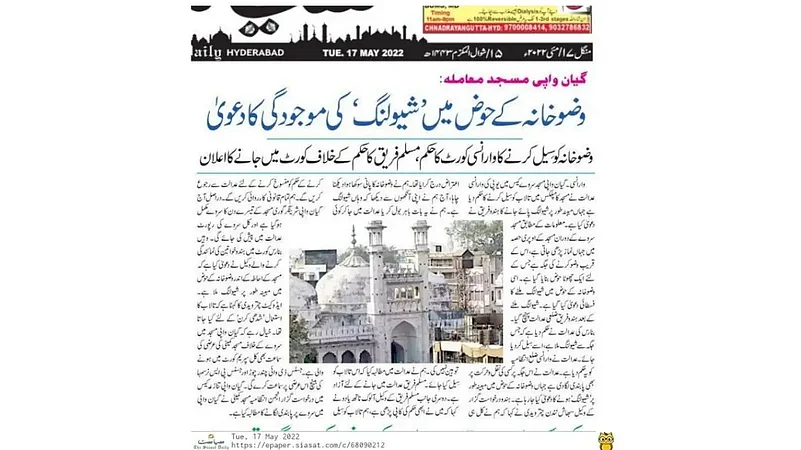
After the Hindu petitioner in the case, Sohan Lal Arya, had claimed that the committee found a Shivling at the complex, the Varanasi district court had issued an order to seal the area. The members of the mosque management committee, Anjuman Intezamiya Masajid, had disputed the claim, stating that the object which was being described as Shivling was, in fact, part of the fountain at the wuzukhana. The ‘discovery’ of Shivling inside the mosque complex, which stands close to the Kashi Vishwanath temple, seemed to reignite the mandir-masjid debate.
Predictably, the politicians jumped on the bandwagon. UP’s deputy chief minister, Keshav Prasad Maurya, tweeted: “Satya hi Shiv hai. (Shiva is truth).” To him, the news of Shivling’s discovery on Buddha Purnima was a ‘message of the country’s eternal Hindu traditions’. All India Majlis-e-Ittehadul Muslimeen (AIMIM) leader Asaduddin Owaisi,on the other hand, expressed hope that the community will not allow the Gyanvapi mosque to be ‘snatched from us’ the way the Babri Masjid was done. The All India Muslim Personal Law Board termed the claim to be ‘unfair.’ It was an ‘attempt to create communal disharmony,’ it said.
If Urdu newspapers like Siasat seemed to be on the side of the mosque, Hindi newspapers like Dainik Jagran and Amar Ujala went the whole hog in favour of the temple, showing more than a shred of bias. A day after the Supreme Court directed that the Shivling must be protected without impeding Muslims from offering namaz, Dainik Jagran wrote in its editorial on May 18 that what was being called Gyanvapi Masjid was actually a part of Kashi Vishwanath Temple, as has been recorded by history. While it’s true that Aurangzeb, in 1669, had brought down the bulk of the Kashi Vishwanath Temple, built by Raja Man Singh during Akbar’s reign — historian Audrey Truschke corroborates this in Aurangzeb: The Man and the Myth (2017) — Dainik Jagran goes a step further: “Just as no proof is needed for this that the mosque was built after demolishing the temple in Kashi, similarly no evidence is needed in the case of mosques built in place of many other temples.”
Sangh Parivar has always maintained that the structures in Varanasi and Mathura would be their next goal after the Ram temple was built in Ayodhya. After the news of the Shivling discovery, supporters of United Hindu Front staged a demonstration in New Delhi, with a placard saying: ‘Ayodhya toh ab hamari hai, Kashi-Mathura, Qutub Minar ki baari hai, aur 30 hazar mandioron ki taiyyari hai (Ayodhya is now ours; it’s the turn of Kashi-Mathura, Qutub Minar, and preparations are on for 30,000 temples).’ Toeing the line of the right-wing, Dainik Jagran, in its editorial, argues that the Gyanvapi template can also be applied to the Idgah mosque built on the Krishna Janmasthan temple in Mathura and the Quwwat-ul-Islam mosque in Delhi: “Even the inscription of Quwwat-ul-Islam mosque says that it was built by demolishing 27 Hindu and Jain temples.” There was no use to resort to citing the Places of Worship Act since the law was not ‘cast in stone’, it says: “It was created to cover up the disputes and it should be known to all that disputes are not resolved by hiding, but by coming to the surface continuously. The Muslims of India should not only accept the truth with open eyes but also refrain from considering cruel invaders like Ghori, Ghazni, Khilji, Babur, and Aurangzeb as their ancestors or inspiration. The Muslims of India did not come from Arabia, Afghanistan, Iran etc. They were the people here whose ancestors were Hindus.”

Compared to Hindi and Urdu newspapers, English dailies maintained a more balanced line. The Telegraph, in its editorial titled ‘At It Again’ on May 19, warned that the ‘lines of conflict were being drawn’ as the BJP was resorting to the tried and tested formulae that worked with the Babri Masjid-Ram Janmabhoomi dispute: “An issue that can divide the people, causing conflict and violence by awakening fear and hatred, is the best way to distract attention from the daily struggle to put food on the plate. The Gyanvapi mosque dispute represents this polarising strategy.” On the same day, The Asian Age, in its editorial, termed the SC move as ‘sagacious’ and expressed hope that it will ensure the judicial pillar of democracy “is braced to live up to its highest expectation” since it was quite unlikely to expect political parties to “forsake partisan gains and electoral windfalls, against the backdrop of more secular and mundane complaints of anti-incumbency — economy, unemployment, inflation, health and education.”
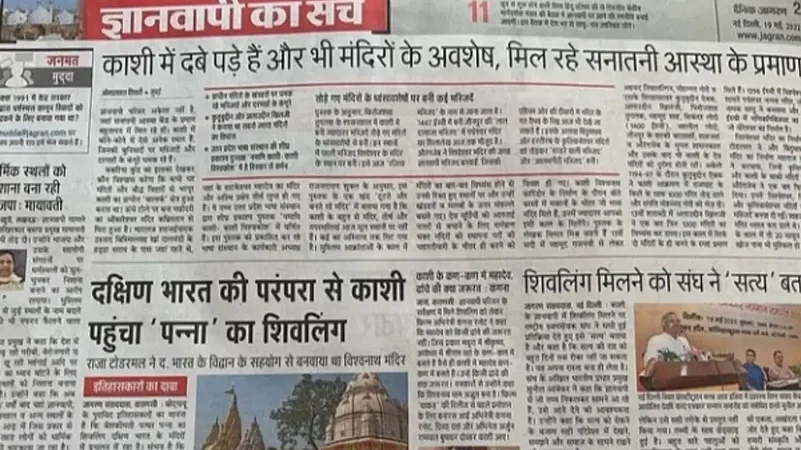
The tension around Gyanvapi had been building for a year since a local court admitted the petition of five Hindu women seeking the right to worship idols installed within the premises. It escalated when the local court ordered a survey of the complex in April, a move which has been opposed by the Muslim side on the basis of the 1991 Act. Hindustan Times, in its May 18 editorial, argues that the 1991 legislation is meant to forestall attempts to follow the Ram Janmabhoomi Babri Masjid template and lay claim to places of worship through the courts: “In the 2019 Ayodhya judgment, the court held the law protects and secures the fundamental values of the Constitution by providing confidence to every religious community that their places of worship will be preserved.” It urges the top court to clarify if this continues to be its position, and then “communicate to all levels of the judiciary to abide by the decision”. The erosion of this law’s mandate, the editorial underlines, can open a “Pandora’s Box of religious strife, discontent and potentially, violence.”






